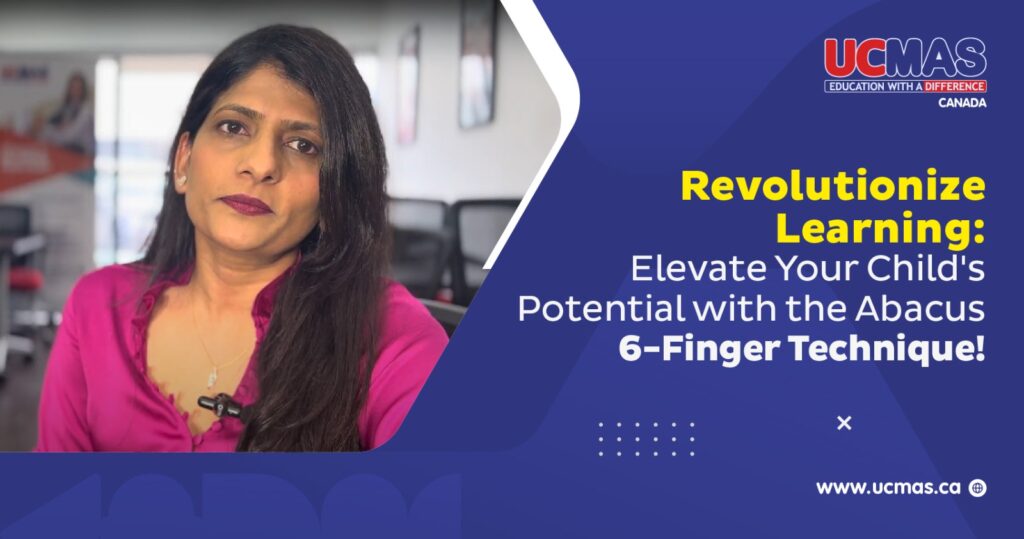
“UCMAS has always led the way in researching and advancing Abacus Math Calculation Techniques. The program was founded by Prof. Dr. Dino Wong, who holds a PhD in this field and stands out for its strong scientific foundation. The continuous upgradation of the curriculum has taken the form of The 6-Finger technique, which as a part of The UCMAS abacus math and mental arithmetic methods is scientifically proven and highly effective to deliver the best results for our children,” said Mr. Rajesh Trivedi, a franchise owner impressed by the research team at UCMAS Head Office, Malaysia.
“A huge portion of the brain’s real estate is devoted to movement, and especially to the voluntary movement of the hands,” an insight by Kelly Lambert, a professor of behavioral neuroscience at the University of Richmond in Virginia. The UCMAS philosophy aligns with this fact. Hence the UCMAS R&D department keeps upgrading the abacus math techniques to serve students best. Let’s explore how it has evolved over the past 30 years.
Evolution of UCMAS Abacus Techniques
The UCMAS abacus math method started simply, using just one hand and two fingers. Over time, it evolved to using both hands and four fingers. Now, we’ve moved to the 6-Finger Technique.
Each step in this evolution was designed to better engage the brain during math calculations. By using more fingers, children activate more parts of their brain. This leads to stronger brain connections and improves their thinking skills. These changes not only meet the learning needs of children but also maximize their brain power. They stimulate important brain areas like the prefrontal, post-frontal, and parietal lobes, which are crucial for thinking and sensing.
Today, the UCMAS 6-Finger Technique is considered the most advanced and effective method globally for boosting brain development in children.
How the Brain and Fingers are Connected
Ever heard of the quote-
“Hands Are Human’s External Brains”
~ Immanuelle Kant, German Philosopher
Well, it is true! Our fingers and brain are closely connected, working together in fascinating ways.
Each finger is linked to specific parts of the brain. For example, the thumb is connected to the motor cortex, while the pinky finger is linked to the sensory cortex. When we engage in complex activities using our fingers, like playing an instrument or writing, it boosts blood flow to different parts of the brain, keeping it sharp and active.
Introduction To The UCMAS 6-Finger Abacus Technique
At UCMAS, kids learn the 6-Finger Technique for mental math. They use the 3 fingers of each hand to move beads on the abacus in specific ways to solve math problems quickly and accurately. This practice not only boosts math skills but also activates parts of the brain linked to numbers, memory, and problem-solving.
The design of beads used in UCMAS is specifically designed to optimize brain stimulation. The shape, texture, and arrangement of the beads are kept in a way that provides a tactile response and enhances their sensory learning experience, further enhancing their cognitive skills.
How It Works
This method involves using both hands to work the abacus, with specific exercises engaging the thumb, index finger, and middle finger. Each finger connects to different parts of the brain:
Thumb: It’s linked to the prefrontal cortex, which manages decision-making and problem-solving.
Index Finger: This finger is connected to areas handling speech and language processing.
Big Finger: It stimulates brain parts dealing with executive functions and fine motor skills coordination.
When these fingers move in patterns on the abacus, they activate the brain areas more than usual, improving blood circulation.
Left and Right Brain Concept
Our brain is like a two-part team, each with its own job-
The left hemisphere of the brain is typically associated with logical and analytical thinking, while the right hemisphere is often linked to creativity and visualization.
Pooja Sundar, COO of UCMAS, explains “When we use both hands together, it’s like giving our brain an extra powerful workout.”
This dual-handed approach encourages better communication and teamwork between the brain’s two halves. This isn’t just good for memory, focus, and problem-solving, it supports the whole brain development and cognitive growth of a child. With regular practice using the abacus, these brain connections get stronger and more efficient, leading to lasting improvements in thinking skills.”
Benefits to Children
Introducing children to the UCMAS Abacus Math Technique between ages 5 to 13 is like planting seeds in a garden when the soil is richest—this is when their brains grow the fastest and soak up the most knowledge. UCMAS recognizes this crucial aspect of every child’s life and helps them make the most of it.
The 6-Finger Abacus Math Technique is a full brain workout that helps children enhance their intrapersonal, logical, kinesthetic, and visual skills, standing out for its whole-brain approach to development. Unlike traditional methods that focus on separate subjects, this technique stimulates the brain as a whole, leading to improvements in:
Memory Enhancement– Moving your fingers over the abacus in continuous patterns helps more blood flow to your brain. This can make you think faster and remember better.
Cognitive Flexibility– It helps children adapt to switching between tasks and thinking about multiple concepts simultaneously, a key component of cognitive flexibility and correlation that escalates brain development.
Fine Motor Skills– Regular practice of abacus math through the UCMAS 6-finger technique improves improve hand skills and coordination, which are essential for everyday tasks.
Health– The UCMAS 6-Finger Technique stimulates fingertip acupoints linked to digestion, respiratory health, immune function, and emotional balance, enhancing children’s overall well-being.
Emotional Regulation: The rhythmic nature of the finger movements has a calming effect on children, which can help in emotional regulation and reducing anxiety.
Conclusion
The 6-Finger Technique is not just a learning method for academic improvement; it is designed to nurture whole brain development in children, instilling deep-seated skills and confidence in their abilities to learn and solve problems creatively. This technique blends ancient acupoint wisdom with modern neuroscience, promoting children’s cognitive, emotional, and physical health for holistic growth.
If you’re eager to give your child a head start in life through a method that nurtures all aspects of their development while helping them master abacus math and mental arithmetic, explore how UCMAS can make a difference. Join us today, and be part of a community that believes in empowering the next generation with the tools they need for success in all facets of life. For more information about our program book an info session.





